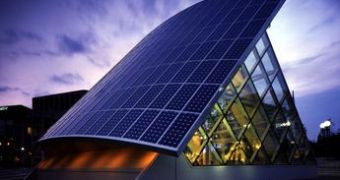The sun is an incredible ball of energy that provides a free, renewable resource in the form of heat and light. Just 20 days of sunshine produces the same amount of energy as all of Earth's reserves of oil, coal and natural gas. Solar energy can be harnessed passively through appropriate design principles as well as actively with collectors that capture the heat or light of the sun.
Utilizing modern solar electric technology, the amount of sunlight that hits an area of 110 square miles could provide enough electricity for the entire United States.
Harnessing this energy is a bit more complicated, but surely not impossible, and it's done through solar cells, or photovoltaic cells.
Photovoltaic cells, as the word implies (photo = light, voltaic = electricity), convert sunlight directly into electricity. Once used almost exclusively in space, photovoltaics are used more and more in less exotic ways. They could even power your house. How do these devices work?
PV cells are made of special materials called semiconductors such as silicon, which is currently the most commonly used. Basically, when light strikes the cell, a certain portion of it is absorbed within the semiconductor material. This means that the energy of the absorbed light is transferred to the semiconductor. The energy knocks electrons loose, allowing them to flow freely. PV cells also all have one or more electric fields that act to force electrons freed by light absorption to flow in a certain direction. This flow of electrons is a current, and by placing metal contacts on the top and bottom of the PV cell, we can draw that current off to use externally.
For example, the current can power a calculator. This current, together with the cell's voltage (which is a result of its built-in electric field or fields), defines the power (or wattage) that the solar cell can produce.
Electricity produced by solar panels can be used independent of the existing electricity infrastructure of a home or it can interact with the electricity coming into the house from the electric utility.
Solar panels are rated in Watts (W), just like a light bulb. A 100 W panel in the sun for 4 hours produces 400 Watt-hours (Wh). This is approximately the same amount of energy required to operate a 40 W light bulb for 10 hours. Electricity bills reflect usage in kilowatt-hours (kWh), which is 1000 Watt-hours (Wh).
In order to generate electricity for a home, several panels, each rated to produce between 120 and 185 W, are required.
But what do we do when the sun isn't shining? Certainly, no one would accept only having electricity during the day, and then only on clear days, if they have a choice. We need energy storage - batteries. Unfortunately, batteries add a lot of cost and maintenance to the PV system. Currently, however, it's a necessity if you want to be completely independent.
The other problem is that the electricity generated by your PV modules, and extracted from your batteries if you choose to use them, is direct current, while the electricity supplied by your utility (and the kind which every appliance in your house uses) is alternating current. You will need an inverter, a device which converts DC to AC. If photovoltaics are such a wonderful source of free energy, then why doesn't the whole world run on solar power?
Well, first of all, they are expensive, and manufacturing needs to be done on a large scale to reduce costs as much as possible.
Second, they take up space. A lot of it. If you have a house with more than one floor, the roof surface will largely remain the same, thus the number of solar panels, but the electricity requirements will increase, and unfortunately, you can't coat your entire house with solar panels.
The final problem is that, Right now, it simply can't compete with the price of centralized utilities.
But don't be disappointed, because solar cells are ideal for remote areas, far from a conventional source of electricity, like a vacation house at the seaside or on a mountain slope, and extremely useful in areas where the sun shines more than half-a-year-long, like California, desert areas, or, why not, your own little tropical island.

 14 DAY TRIAL //
14 DAY TRIAL //